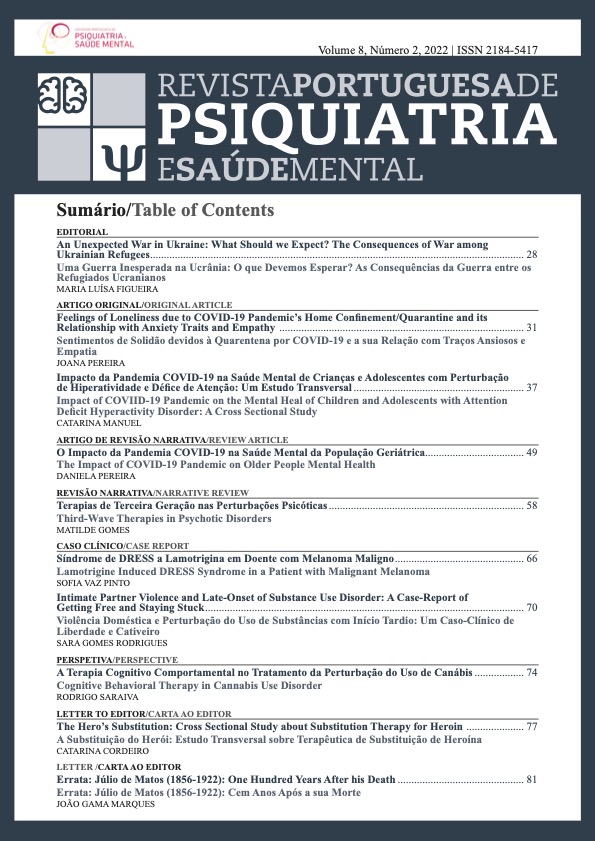Lamotrigine Induced DRESS Syndrome in a Patient with Malignant Melanoma
DOI:
https://doi.org/10.51338/rppsm.314Keywords:
Drug Hypersensitivity Syndrome/etiology, Lamotrigine/adverse effects, Melanoma/drug therapy, PolypharmacyAbstract
A síndrome de DRESS (drug reaction with eosinophilia and systemic symptoms) constitui uma forma rara de reação adversa medicamentosa grave com envolvimento sistémico. Descreve‑se
o caso clínico de doente com diagnóstico de
melanoma maligno, que se dirigiu ao serviço de urgência com quadro de exantema morbiliforme generalizado, edema facial e astenia. Encontrava‑se
sob terapêutica com pembrolizumab desde há 5 meses e, no contexto de depressão bipolar,
tinha iniciado lamotrigina 14 dias antes da admissão. Analiticamente destacava‑se
trombocitopenia, eosinofilia, PCR elevada e alterações das provas hepáticas. Considerou‑se
o diagnóstico de síndrome de DRESS a lamotrigina, tendo este fármaco sido suspenso e iniciada corticoterapia sistémica, com resolução completa do quadro em 30 dias. A suspensão do fármaco responsável constitui a medida mais importante na redução da morbilidade e mortalidade associadas à síndrome de DRESS. A identificação do agente causal em doentes polimedicados pode tornar‑se
um verdadeiro desafio.
Downloads
References
Bommersbach TJ, Lapid MI, Leung JG, Cunningham JL, Rummans TA, Kung S. Management of Psychotropic Drug–Induced DRESS Syndrome: A Systematic Review. Mayo Clin Proc. 2016;91(6):787–801.
Ganeva M, Gancheva T, Lazarova R, Troeva J, Baldaranov I, Vassilev I, et al. Carbamazepine-induced drug reaction with eosinophilia and systemic symptoms (DRESS) syndrome: Report of four cases and brief review. Int J Dermatol. 2008;47(8):853–860.
Criado PR, Avancini J, Santi CG, Medrado ATA, Rodrigues CE, Carvalho JF De. Drug Reaction with Eosinophilia and Systemic Symptoms (DRESS): A Complex Interactio of Drugs, Viruses and the Immune System. IMAJ. 2012;14:5–10.
Vaillant L. Drug hypersensitivity syndrome: Drug rash with eosinophilia and systemic symptoms (DRESS). J Dermatolog Treat. 1999;10(4):267–272.
Pinheiro AE, Ferreira R, Ferreira GC, Varandas L. Síndrome de hipersensibilidade aos antiepilépticos na criança. Acta Med Port. 2010;23(4):715–718.
Chu CY, Chen YC, Chiu HC. Drug reaction with eosinophilia and systemic symptoms: A retrospective study of 60 cases. Arch Dermatol. 2010;146(12):1373–1379.
Choudhary S, McLeod M, Torchia D, Romanelli P. Drug reaction with eosinophilia and systemic symptoms (DRESS) syndrome. Clin Dermatol. 2013;6(6):702–711.
Lobo I, Ferreira M, Velho G, Sanches M, Selores M. Erupção a fármaco com eosinofilia e sintomas sistémicos (Síndrome DRESS). Acta Med Port. 2008;21(4):367–372.
Tawhari I, Tawhari F, Aljuaid M. Lamotrigine-induced drug reaction with eosinophilia and systemic symptoms (DRESS) during primary Epstein-Barr virus (EBV) infection. BMJ Case Rep. 2018;2018:2017–2018.
Husain Z, Reddy BY, Schwartz RA. DRESS syndrome: Part II. Management and therapeutics. J Am Acad Dermatol. 2013;68(5):709.e1-709.e9.
Um SJ, Lee SK, Kim YH, Kim KH, Son CH, Roh MS, et al. Clinical features of drug-induced hypersensitivity syndrome in 38 patients. J Investig Allergol Clin Immunol. 2010;20(7):556–562.
Fleming P, Marik PE. The DRESS syndrome: The great clinical mimicker. Pharmacotherapy. 2011;31(3):3103. doi:10.1592/phco.31.3.332
Chen CB, Wu MY, Ng CY, Lu CW, Wu J, Kao PH, et al. Severe cutaneous adverse reactions induced by targeted anticancer therapies and immunotherapies. Cancer Manag Res. 2018;10:1259–1273.








